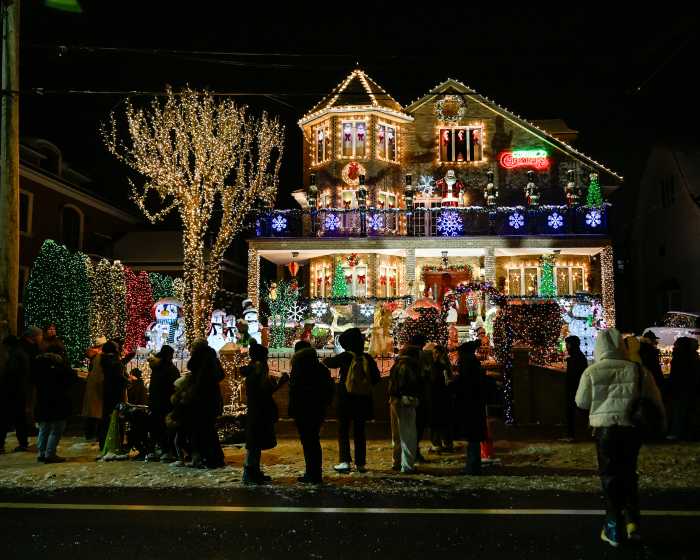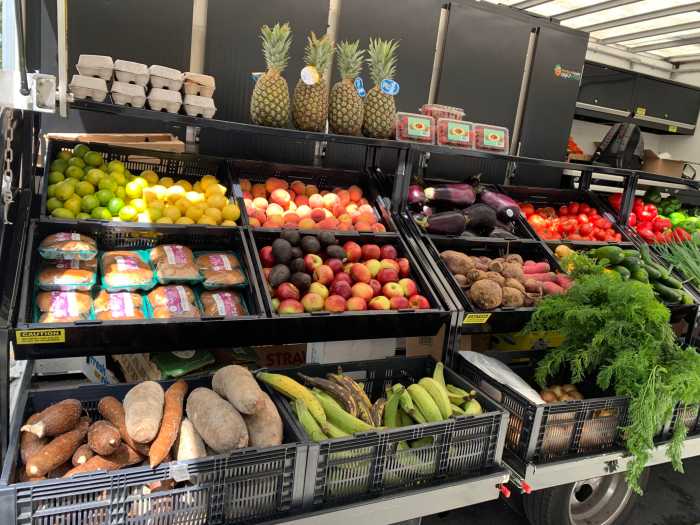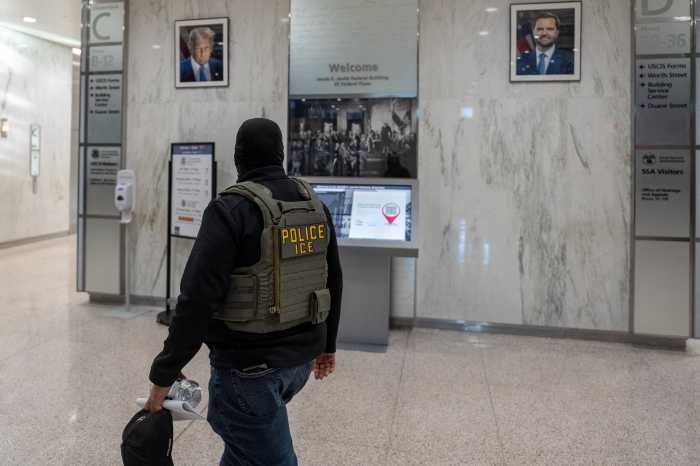To the editor,
I have written about the deterioration of Kings Highway before, but things just seem to keep going downhill. Thanks to Councilman Deutsch, the bike rack under the station has been cleaned up, but that is about the only good thing that has happened. There are several empty stores, more than I can remember, and there are more to come. There is a drugstore on almost every block, some that sell childrens’ cloths, pocketbooks, and jewelry. As for banks, from Coney Island Avenue to E. 19th Street, a distance of of eight blocks, there are about 17, unless I missed one or two.
The other morning, walking on the Highway, I heard a man yelling at the top of his lungs. When I got to 15th Street I saw why. He was standing outside his car screaming at the traffic, which was at as complete standstill in three directions. Trucks parked and double-parked for deliveries, trucks, buses and cars trying to get through, and nothing moving. Unfortunately it is only going to get worse. Not one building going up is providing any parking. Not the monstrosity on the corner of 16th Street and the Highway, nor will the medical centers going up on 16th between the Highway and Avenue P, or the one that will be on Avenue P. Certainly not the Target/Marshall building, which is at five stories and who knows how many more. People in the nearby apartment buildings have lost their view, and the people on 13th Street next door to that building are having their side windows sealed up. They can’t open them, so there is no fresh air, no light, and no room for an air conditioner. They are making tombs out of rooms and the only ones that would be happy there are moles.
A big apartment building went up on 19th off Avenue P. Did they provide enough parking? I doubt it. Another building will go up on the corner of Avenue P and E. 19th Street, which will be stores and apartments. Will they provide parking?
It will get to the point that people won’t want to come to the Highway unless they don’t have a car. People can go to the Gateway Shopping Center, on the Belt Parkway, which has every store you can think of and plenty of free parking.
Someone has to come to their senses and stop what is happening.
Rowena Lachant
Homecrest
Bus route dispute
To the editor,
There are many inaccuracies in Martin Samoylov’s pro-B82 SBS letter that appeared in the editions of March 30.
First, he talks about “all the work DOT has done to engage the community.” Quite the contrary, Department of Transportation has deliberately tried not to engage the communities. Why have they made presentations only to community board transportation committees and not the full boards, so that the general public could ask questions? When I sent DOT a lengthy suggestion last year suggesting improvements and changes to their proposal, why did I only receive a form e-mail thanking me for my suggestions, but no willingness to discuss or respond to them? They were totally ignored.
Why is it necessary to negotiate a dozen different cumbersome menus on the DOT website to find any information about this proposal and why is no information available on the MTA website? So it will be no wonder when this SBS route comes at a complete surprise this July to most, just as each SBS route before it.
Second, he states that 27,000 individuals use this route each day. That is 27,000 weekday trips, not 27,000 individuals, Mr. Samoylov. So if we assume most passengers make the same round trip daily, the actual number is closer to 15,000 individuals. It is precisely this type of dumb mistake that causes the DOT and the MTA to make dumb decisions.
Third, like DOT, he equates “Bus Rapid Transit” to “Select Bus Service” when there are few similarities. Check “ BRT Standards” in Wikipedia and you won’t even find New York City on the list of cities with true BRT routes. And like DOT he calls SBS a solution that has “helped multiple other bus routes” with zero proof to back up that statement.
Under this proposal two lanes of general lanes of traffic would unnecessarily be removed between E. 22nd Street and Avenue K around the clock, and the service roads narrowed, creating traffic congestion where none exists now so that buses that move currently at an average speed exceeding 20 miles per hour (according to DOT’s own data) most of the day could move faster. The speed limit is only 25 mph, so will their average speed increase from 21 mph to 23 mph at a tremendous initial cost and increasing ongoing costs? That is the real joke, not that sensible individuals want another option.
DOT’s most recent Brooklyn SBS route, the B46, has been such a disaster that the MTA never issued a progress report after several years of operation because they cannot find anything good to say even by distorting the data as they have done with each previous SBS review.
Finally, where is Mr. Samoylov getting his information that more than 100 parking spaces will be created to replace the ones lost? Or is he just making it up just like DOT makes up their own facts? If that were actually the case, there would be no reason for many elected officials to band together to oppose this proposal.
The only agreement we have is the need for all traffic to move quicker between Coney Island Avenue and Ocean Avenue, but we don’t need SBS to accomplish that and I do not think that DOT’s plan in that area is a bad idea, provided the parking could actually be replaced as Mr. Samoylov states that it will be. But we also need to restrict delivery times as DOT is trying to do elsewhere, but the merchants are opposing.
It is curious why you reached out to Mr. Samoylov for comment to your SBS article and also published a lengthy letter from him. It really must be difficult to find B82 SBS supporters. When implemented, this will be another SBS failure. Sad because there is real potential for a good Southern Brooklyn SBS route if the MTA would only listen to reason.
Allan Rosen
Sheepshead Bay
Gun violence: Stop it!
To the editor,
After each school shooting, many individuals provide sound solutions to protect our kids — but there is no subsequent action. Consider that after the Parkland, Fla., shooting on Feb. 14, where 17 were killed and 14 were injured, there have been four additional school shootings in the country, leaving four dead and seven injured — and the time of this writing is March 25. Apparently there was little action after Parkland.
Below is a cursory look of up-to-date particulars of school shootings in 21st-century America (until March 25). Remember that these are not detailed statistics with in-depth analysis, but only an attempt to get politicians to act. Anyone viewing these statistics can arrive at his or her own conclusion; my conclusion is that one school shooting is too much.
• 211 total school shootings — 481 dead, 488 injured
• 58 can be considered massacres or attempted massacres
• 153 shootings specifically targeted certain individuals
• 110 shooters were under 25 years of age (the age of maturity)
• 55 shooters’ ages cannot be determined, but since the shootings occurred in or around schools, we can surmise that many were under 25 years of age, which would add to the 110 figure.
Some mentally ill individuals have been able to purchase firearms legally or use others’ legally purchased firearms. Some experts have noted that shootings by mentally ill individuals are about four percent, while others have placed that figure at about 10 percent.
Perhaps Congress, law enforcement or anyone else who wants a detailed study, can do the research and release the findings publically. I’m only providing this data so perhaps someone without a political agenda who cares about our schoolkids will act.
There is no one-size-fits-all solution. Using non-intrusive detectors, as described in detail by state Sen. Marty Golden, is the best device for stopping both shooters with targeted victims in mind and some mass shooters (but not all mass shooters will be stopped). Sen. Golden’s detectors would obviously detect the firearm of all shooters, but it is likely that some shooters with maximum casualties in mind would begin shooting at the entrance — and continue. Additional tools to minimize mass shootings, in addition to Mr. Golden’s non-intrusive detectors, are an age restriction of 25 for buying–using–discharging a firearm, and a National Mentally Ill Registry.
Additionally, limit the school entrance to one (if possible) with an armed law enforcement person at each unlocked entrance — preferably, one who does not run away from the shooter. All other doors must be locked with an emergency egress bar that will activate both an alarm and a signal to local law enforcement — and for Pete’s Sake, remove the silly “This is a gun free zone” sign; the sign is an invitation to shoot.
How many lives must we lose before our so-called leaders act decisively? Gun violence must stop — and it must stop now.Elio Valenti
Bay Ridge























